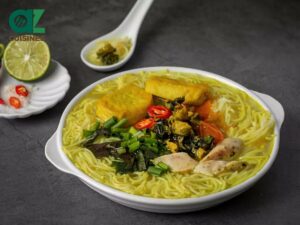#125 in Vietnam
Ốc Nấu Chuối Đậu: Basic Information
Pronunciation
Alternative Name(s)
Dish Type
Course
Mealtime
Popular Variations
Ốc Nấu Chuối Đậu: Ingredients and Preparation
Main Ingredients
Main Cooking Method
Preparation Process
Ốc Nấu Chuối Đậu: A Deep Dive
Cultural Significance
Taste
Texture
Aroma
Color
Serving Style
Serving Temperature
Accompaniment
Occasions
Seasons
Special Diets
Calories
Popularity
Popular Similar Dishes
- Bún Ốc
- Bún Riêu Cua
Popular Dining Area
Ốc nấu chuối đậu, or ốc om chuối đậu, is a familiar Vietnamese dish, especially in the Northern region of the country. The main ingredients of this dish, as its name suggests, are snails (called “ốc”), green bananas (chuối), and tofu (đậu). Other additional components are fermented rice (“mẻ”), pork belly, turmeric, and Vietnamese perilla.
The snail used in ốc nấu chuối đậu is traditionally Pila conica. Overall, the dish is appealing with light yellow-colored broth, thanks to the turmeric. It has a perfectly balanced flavor of savory meat and snail and slightly sour vinegar (or fermented rice).
Ốc nấu chuối đậu is a humble dish for regular family meals or special gatherings, normally eaten with rice or noodles. Besides the above information, you’ll learn more about how to make this Vietnamese delicacy at home with ease. Then, let’s uncover some advantages and disadvantages of eating ốc nấu chuối đậu.
Finally, for more on dishes similar to Ốc Nấu Chuối Đậu, you should see the similar dishes section below. So let’s continue reading for further details.
Key Points
How To Make Ốc Nấu Chuối Đậu?
Here are 6 key steps to prepare a hot pot of ốc nấu chuối đậu at home:
Step 1: Prepare the Snails
Soak snails in rice wash and chili water, then boil briefly. Remove meat, discard innards, and rinse. Keep the snail-cooking water aside.
Step 2: Prepare Fermented Rice and Turmeric Juice
Strain fermented rice for a smooth texture. For fresh turmeric, grind it with vinegar or lemon juice for color.
Step 3: Prepare the Green Bananas
Peel and slice four green bananas, soaking them in diluted lime juice to prevent darkening.
Step 4: Cook Tofu and Pork Belly
Deep-fry tofu into bite-sized pieces. Stir-fry or sauté pork belly slices until the edges are crispy.
Step 5: Combine Ingredients
Add the pork belly, sliced bananas, and the water used for boiling the snails into a pot. Simmer them for 15 to 20 minutes until the broth is slightly thickened. Finally, add the snails and fried tofu and simmer for another 4-5 minutes.
Step 6: Garnishing
Add chopped green onions and perillas, and serve hot.
Though ốc nấu chuối đậu is a tasty dish, there are other things that you should consider. Check the following pros and cons section for more information.
Pros and Cons of Eating Ốc Nấu Chuối Đậu
With the table below, you’ll have a better view at ốc nấu chuối đậu of Vietnamese cuisine.
Pros
Cons
Next, let’s see what other concerns eaters normally have regarding eating this Vietnamese snail stew with green bananas and tofu






Truc Tran (Kris)
Senior Food Editor
Expertise
Home Cooking, Meal Planning, Recipe Development, Baking and Pastry, Food Editor, Cooking-video Maker, Vietnamese Food Evaluation Expert
Education
Truc Tran (Kris), an experienced food writer and editor, is great at exploring and describing global cuisines, from simple street food to fancy dining. In her writing, she skillfully mixes different flavors, cooking methods, and culinary traditions, showing the unique character of various cultures through their food and drinks. On azcuisines.com, Kris highlights her knowledge, especially in Asian cuisine and worldwide traditional dishes.